Featured Products
It’s confession time. I used to think that modern photographers who used film cameras had lost their minds. I admit it, I judged them a bit. Who would use film vs digital?
Who on earth would PAY for film and then PAY again for developing and WAIT for the images? For only 24 or 36 frames? What kind of Koo-laid were they drinking? I was happy shooting 600 frames per session and checking the back of my LCD after each change in lighting. I mean, advances in cameras have come a long way and image quality is better than ever.
Deep down inside, I think was actually…jealous? I mean, who really gets perfect shots straight out of the camera? Especially if you can’t even take a peak at the histogram to ensure the image is properly exposed. I was not interested.
But then it happened. Earlier this year, I found my dad’s old broken film camera, the one he used for private detective work. (Admittedly, the camera has quite a bit of sentimental value because it was used to take my baby pictures.) I took it in to the local shop to get fixed. Turns out, it just needed a battery–not broken after all these years! I purchased a roll of black and white, had someone teach me how to load it properly, and was on my way. Here are some images from that first roll.
At this point, I realized that being able to use my Canon lenses was a huge advantage so I picked up a Canon film camera for just $100. As a personal challenge, I took all of my son’s birthday party photos using this new setup. Many were underexposed, but overall, I was so pleased. This photo of my son and father made me realize that film images have a timeless look to them that cannot be matched on digital.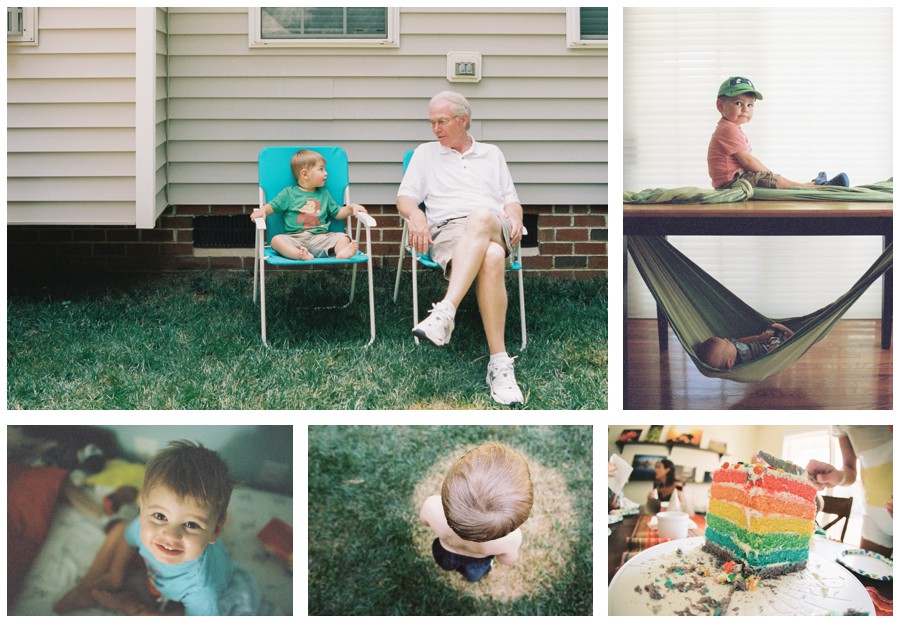
Film Vs. Digital – Can You Tell?
I can, in a heartbeat! But to an untrained eye, it may not be so obvious. The image on the left is a film image and the image on the right is a digital image. Both were taken on the same day with the same background and same lighting. Both are sharp, similarly composed, and adjusted for skin tone. Which image do you prefer?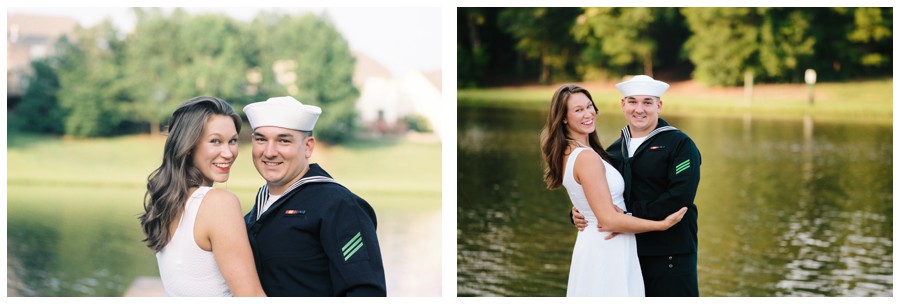
Benefits of Film
1. Better Tonal Range – Film captures highlight and shadow detail much better than even the best digital sensors. Especially with color film, it’s almost impossible to blow out the highlights of an image. I have far fewer blown skies with film. Plus, I can shoot in bright daylight and not blow out my skin tones. Shooting in mid-day sun is harsh and difficult, but with film, the results are downright beautiful.
2. Level Playing Field – It doesn’t matter what camera you use! Forget the digital camera war over megapixels. Film is film and it only costs a few dollars to go from consumer level film to professional quality. Obviously, the better cameras have more features but the part of the camera that captures your image is the same. Even on 35mm film, the part of the film that captures the image is the same size as a “full-frame” digital camera. (Hence the name.) With medium format cameras, the negatives are much larger and can capture a remarkable amount of detail. With an experienced film lab or a great scanner, you can have amazing quality images for much less than a Canon 5D Mark III.
3. Minimal Editing Time – Each film stock has it’s own look so most people just make small adjustments to their film scans. This means post processing work is mostly cropping and basic adjustments. Sometimes an image needs more contrast or some extra brightness. With digital, I keep about 20% of my shots. With film, I’m above 80%. What an incredible difference! I enjoy using actions from MCP Newborn Necessities to help make these basic adjustments to my film images. The skin correction tools like in Newborn Necessities and Magic Skin are helpful as well. My favorite skill for editing the film images is the color cast correction method I learned in MCP’s Color Correcting Class. It’s a great way to minimize the bright casts from grass, clothing, or other objects.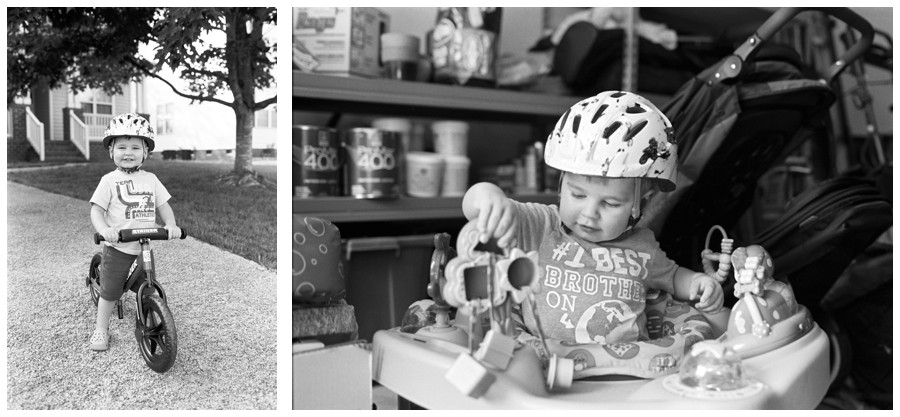
Benefits of Digital
1. RAW Images Rock – RAW images contain so much information that even more major exposure issues can be addressed in post processing with minor loss of image quality. Film requires more precision because film scans are effectively jpgs.
2. Low Light Conditions – When I do in home images, I’m routinely shooting at ISOs of 1600-4000 with beautiful results. With film, I’m usually shooting at about ISO 100-400 and that makes indoor photography more difficult. A handheld light meter helps me meter properly but I have to be very careful about finding indoor locations with enough light. This is probably the primary reason I will stick with shooting both digital and film long term.
3. Editing Freedom – I enjoy editing immensely and having a beautiful digital image and MCP Actions allows me to create so many different looks. Instead of rolling with whatever my scan looks like, I can create a high key black and white or a matte finish color image with fall tones from the same file.
Glass Half Full or Half Empty? YOU Decide – Film vs Digital.
1. Fine Tuned Metering Skills – For the first time in a long while, I paid special attention to metering. Instead of it being an afterthought, metering became the most important part of photography. Without having the back of the camera or a RAW format to account for errors, suddenly it mattered if my skin was properly exposed or at +1. My digital photography has improved substantially as a result.
2. Thinking Before Shooting – Instead of taking a dozen frames when my son was being “cute”, I’d wait until just the right moment. Sure, I’ve missed some moments as a result, but I’ve also learned patience and become comfortable with composing images more deliberately. Again, I’m seeing benefits in all areas of photography.
3. Learning to Wait – Having to send film, wait a week, then download scans in .zip format isn’t for the faint of heart. It’s agonizing. But the surprise and anticipation, like with all things in life, is WORTH IT. I’m finding shots I didn’t remember taking, relishing the joy of a perfectly focused portrait, and seeing improvement month to month. In our world of instant gratification, going back to the basics is refreshing.
4. Aesthetics – Film has an indescribable characteristic that makes it special. Digital photos at high ISOs have noise but film images have grain. It’s similar in concept, but the results are different. Grain has a beautiful quality that reminds you of old photos with grandma. Different film stocks have grain that is different shapes and sizes. Film stocks also have a look to them, similar to the way an image looks when edited. These looks can change when the film is purposely underexposed or overexposed or when the film is pushed or pulled in processing. By playing with these variables, photographers create a look that is their own.
5. Enhanced Creativity – Because I am comfortable that some of my shots might not come out, I don’t mind experimenting more. My creativity is improving and I’m developing as an artist.
6. Putting Down the Camera – Hate experiencing an event through the lens? Ever will yourself to put down the camera and come up short (and with 2000+ frames?). Who me? Shooting film allows you to enjoy the photography process and then stop once the film is gone. Gone means gone! It’s a great way to force yourself to be in the moment. But at the same time, if something incredible happens, you might be stuck with only the cell phone camera.
7. White Balance – With film, you don’t set white balance. It’s daylight balanced and can be adjusted slightly in post processing or scanning. This is great for portraiture because you no longer have to go through the laborious process of editing white balance or skin tone–it’s usually about right straight out of the camera. However, film doesn’t always have as much success under extreme light temperatures like tungsten without a special filter. (You can see in the images below that the color temperature of the right image is a bit off due to the florescent light source. The image on the left is window light.)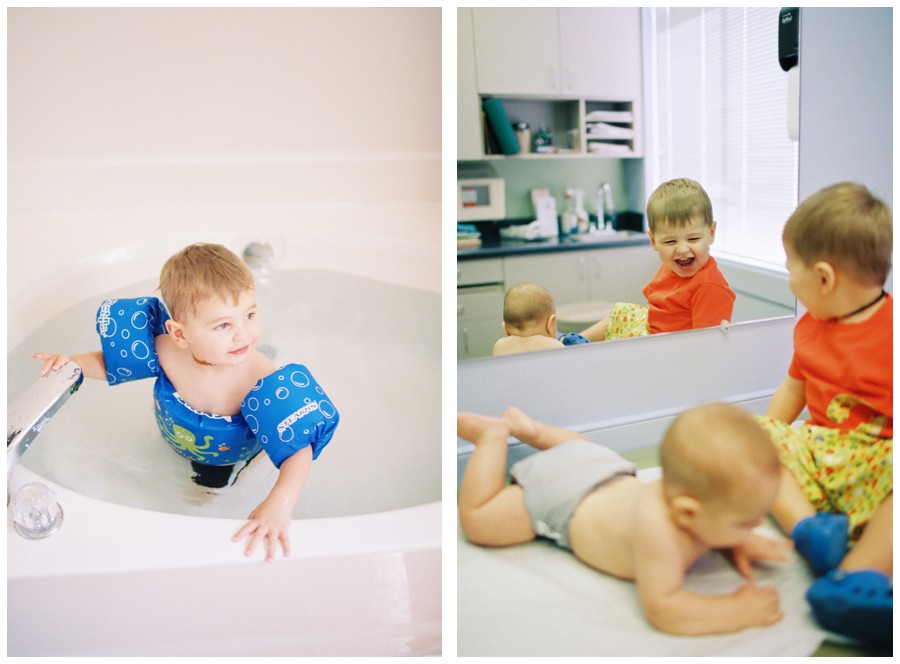
My Answer: It Depends
After weighing these criteria, I chose to shoot exclusively film when I took my sons on a 1,300 mile road trip alone. I took a Facebook holiday and 7 rolls of film and carefully monitored my usage. Because it was a trip to see relatives I was able to focus on family only and photograph only what really mattered to me–relationships and improving my photography. I am more proud of those 7 rolls than of any other photos I’ve taken to date. They represent a week of restraint, paying attention to details, and being patient. Here is a sampling from that trip.
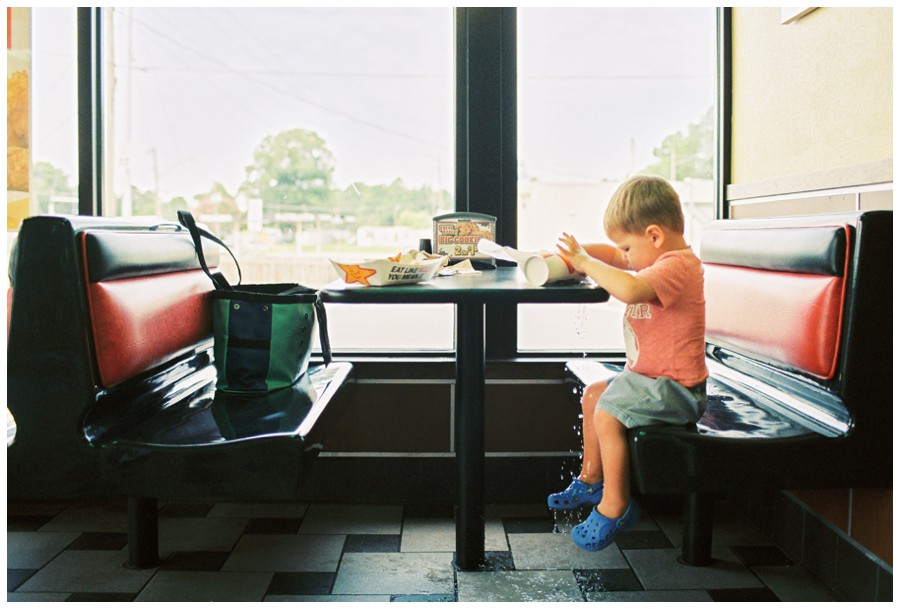
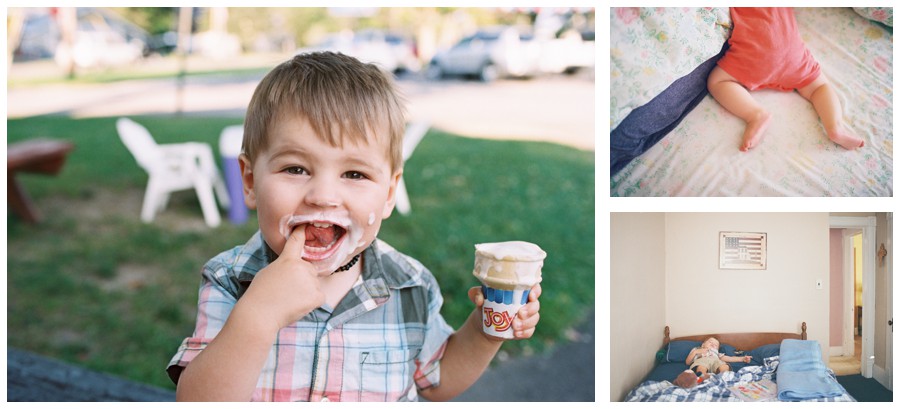
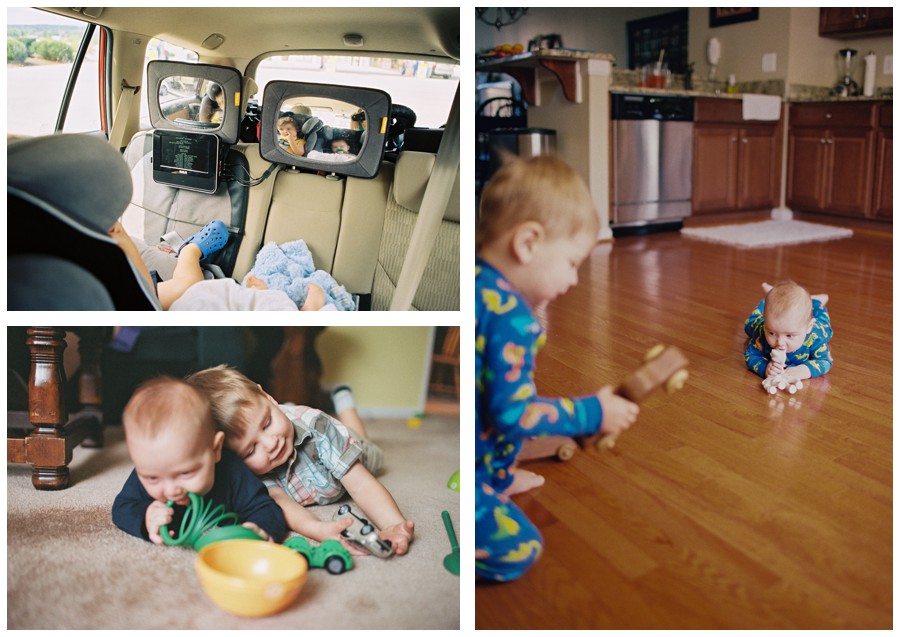
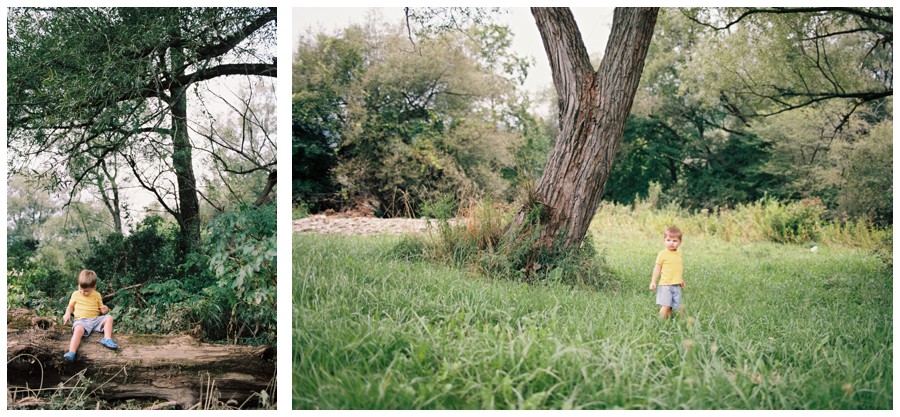 Currently, I use film for most of my personal work and stick with digital for my professional work and find that balance to be perfect for me. Have you ever considered heading back to film? Are you shooting some now? Tell me in the comments!
Currently, I use film for most of my personal work and stick with digital for my professional work and find that balance to be perfect for me. Have you ever considered heading back to film? Are you shooting some now? Tell me in the comments!
Note: With the exception of the single digital image above for comparison, all images above are film. Photos taken with a Yashica FX-2 and Canon EOS 1-N + 35mm f/1.4 + 85 f/1.8. Film stocks include Portra 160, Portra 400, Portra 800, Tri-X 400, Ultramax 400, expired Fugi Walmart 200, and Kodak BW CN. Film processed and scanned by Indie Lab and theFINDlab.
Jessica Rotenberg is a family and child photographer in Raleigh, NC who specializes in modern portraiture and creating beautiful wall galleries for clients. She enjoys mentoring other photographers and participating on the MCP Actions Facebook group page. You can also follow her on Facebook.
No Comments
Leave a Comment
You must be logged in to post a comment.







































I love film! My film stuff is pretty much exclusively personal but I love both black and white and color film. My next project is, at some point, to use some portra 160 in my studio with the lights.
I use film for most of my work and I develop it at home try several method, I agree in total Ways with this article.
This is so fun! I was very hesitant to jump into digital, but since I’d left my really nice Canon in the back of a taxi in Costa Rica (don’t ask) I didn’t have much choice. It seemed that was the way the world was going. But I’m so thankful that I learned on a manual, it has made a difference just going in.I wish I’d known about that lab a couple years ago though, I took some underwater pics on a vacation and paid through the nose to have the film developed. 🙁